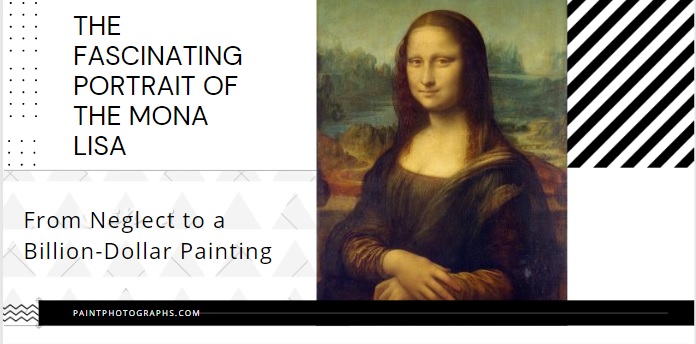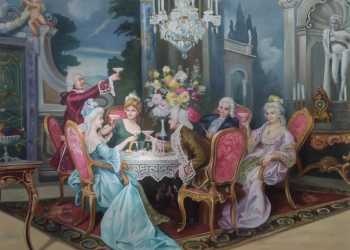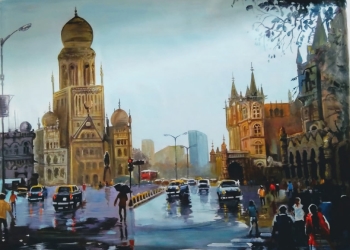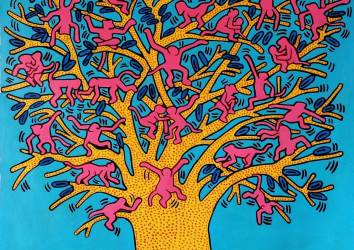Read all about how a portrait painting by Leonardo da Vinci become the world's greatest art icon Mona Lisa
Introduction:
Monalisa is one of the most iconic artworks of all time. Leonardo da Vinci's masterpiece attracts more visitors to the Louvre than the next 5 most famous paintings of the world. Estimates put that 80% of visitors to the Louvre museum visit it only to view the Monalisa painting.
Here’s an estimated number of annual visitors to the top 6 paintings of the world
6. The Last Supper - 460000 visitors/ year
5. The Scream - 500000 visitors/ year
4. The Girl with a pearl ring - 1500000 visitors/ year
3. Starry Night - 3000000 visitors/ year
2. The Sistine Chapel - 5000000 visitors/ year
1. Monalisa - 10000000 visitors/ year
If the number of visitors to Monalisa was to form a country, it will rank as 97th most populous country in the world. With a higher ranking than Switzerland, UAE, and Belarus.
But Monalisa was not always famous. For close to 4 centuries, it was just another painting. Lying neglected, with few giving it a second glance, and definitely, no one was queuing up to see her. So how did the Monalisa painting become so famous?
It was not until the year 1911 that Monalisa truly gained the recognition that she deserved. On 21 August 1911, a thief walked into the Louvre and stole the painting. Sparking an intense search for her whereabouts. Though it took two years to recover her, this incident suddenly made people all over the world aware of her existence. Monalisa had finally made it to the public's eye.
But let's begin at the beginning. Here is the story of Monalisa turning from another piece of art to a billion-dollar painting.
At the Beginning - Is the Mona Lisa a real Person? - The Making of Monalisa
While there are many theories about Monalisa and her origins. The generally accepted story by scholars goes something like this. In 1503, to celebrate the birth of his second son Andrea, and his new home, Francesco del Giocondo, approached Leonardo, to commission him to make an oil portrait painting of his wife, Lisa del Giocondo. Perhaps an anniversary gift.
At 51, when he received the commission, Leonardo was already famous as an artist and a polymath. And he bought a lifetime of experience, innovation, and inventiveness to bear on the portrait painting of Lisa del Giocondo. Now popularly known as Monalisa. Though unfinished, he made the oil portrait painting on poplar panel measuring 30 inches x 21 inches (77 cm x53 cm)
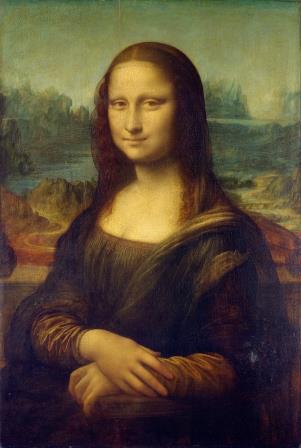 Monalisa by Leonardo da Vinci (Image credits: Wikicommons.org)
Monalisa by Leonardo da Vinci (Image credits: Wikicommons.org)
Title: Monalisa
Creator: Leonardo da Vinci
Date Created: 1503–1506, perhaps continuing until 1517
Physical Dimensions: 30 inches x 21 inches (77 cm x 53 cm)
Medium: Oil portrait painting on poplar panel
Location: Louvre Museum, Paris, France
Handmade Art Reproductions & Landscape Paintings
Painting Techniques used for Mona Lisa:
To give The Mona Lisa its life-like appearance, Leonardo da Vinci used certain painting approaches. He used a method called sfumato, which gradually transitions hues together, resulting in a "misty" border with no distinct lines. The other art pieces of the time had much more precise lines. He used another method called glazing. Where one applies many tiny thin layers of paint, making a body part look more realistic (see the Mona Lisa’s hand).
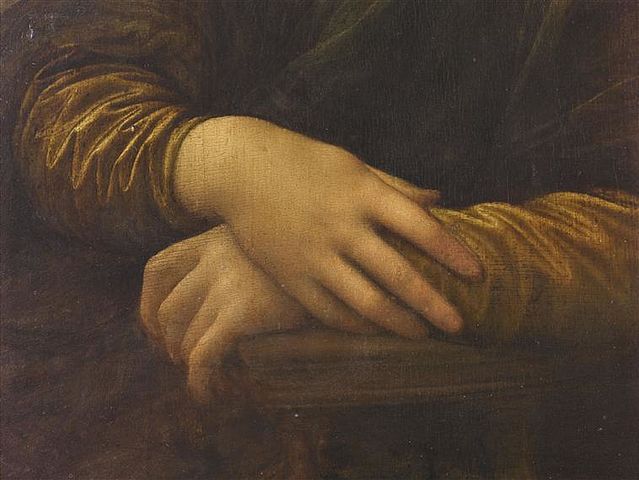 Monalisa's hand details (Image credits: Wikicommons.org)
Monalisa's hand details (Image credits: Wikicommons.org)
The eyes and the secret of Monalisa's smile:
The Mona Lisa is famous for its enigmatic smile and the illusion that the eyes seem to follow the viewer around the room. The effect, known as "the Mona Lisa effect," is associated with Leonardo da Vinci. His understanding of human anatomy and painting techniques helped to create the illusion.
Many Experts have studied the Mona Lisa. To understand the scientific explanations for the Mona Lisa effect. They have found that in the three-dimensional world, the shadows and light on a face shift as our perspective changes. But, this is not the case in a two-dimensional portrait painting. As a result, the painting's eyes seem to follow us even when we are not directly in front of it.
But more than the eyes of the Mona Lisa, Leonardo da Vinci's mastery of painting techniques is evident in the famous Mona Lisa smile. The enigmatic expression is the result of Leonardo's in-depth study of the human face. Including the muscles and nerves that control facial expressions. To understand how smile forms, Leonardo spent many of his nights in the morgue at the hospital of Santa Maria Nuova. There he dissected cadavers to learn how smiles forms.
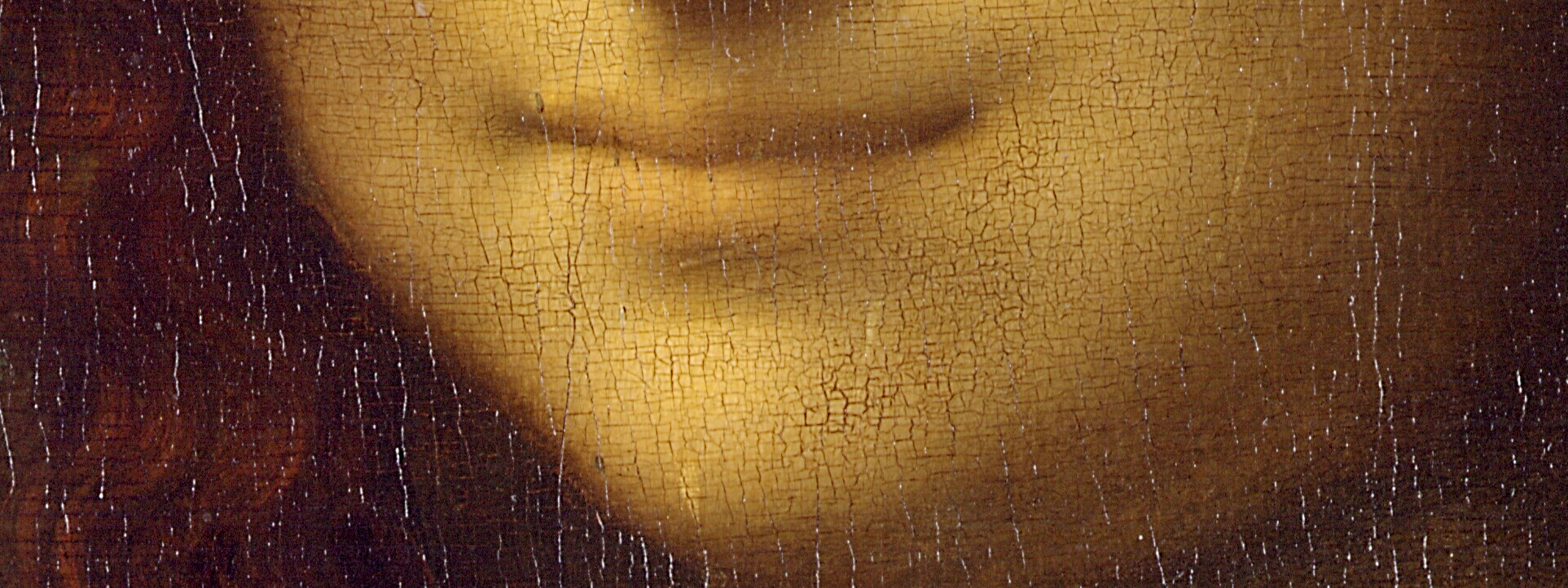 Details of Monalisa's smile (Image credits: Wikicommons.org)
Details of Monalisa's smile (Image credits: Wikicommons.org)
He also used his knowledge of human eyes and perception to create the Mona Lisa's enigmatic smile. Leonardo understood that light rays do not focus on a single point in the eye, but instead hit the entire retina. This means an object appears sharp when we look straight at it, but blurry when we see it peripherally. As if it were farther away.
 Leonardo da Vinci, anatomical sketches of a smile (Image Credits: Wikicommons.org)
Leonardo da Vinci, anatomical sketches of a smile (Image Credits: Wikicommons.org)
Leonardo used these principles to create a smile that appears to change depending on the viewer's perspective. When viewed directly, the smile appears neutral, but when viewed peripherally, it appears to turn upward into a subtle smile. This is due to the way the viewer's retina perceives the shadows and soft sfumato at the edge of her mouth. Giving the impression of a smile despite the lack of clear boundaries at the corners of the mouth.
Depth and Perspective of Mona Lisa:
Before Leonardo, paintings of the era were unidimensional and flat. Perspective and depth were missing. As the portrayal of the subjects was made against the flat monochrome surface. Thus oil portrait paintings of the era lacked depth and the realistic look which we now take for granted. Leonardo used an aerial perspective. By placing Mona Lisa, against a backdrop of an imaginary landscape. With distant mountains winding paths, and a distant bridge. He infused the painting with a sense of mystery and depth not seen before.
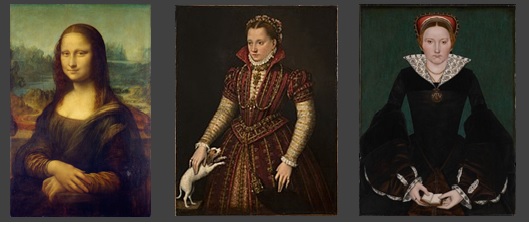 Monalisa and Other portraits of the Renaissance era. Notice the flatness?
Monalisa and Other portraits of the Renaissance era. Notice the flatness?
(Image Credits: Wikicommons.org)
Order Your Portrait Painting from Photo today!
All the factors added up to give the painting a unique feel at the time. How Leanardo executed his commissioned oil portrait painting, created an impact on the art world of the time. As per Giorgio Vasari, an artist, architect, historian, and author of that era. He wrote of the Lives of the Most Excellent Painters, Sculptors, and Architects. Considered a bible of Western art. He wrote, “In this work of Leonardo, there was a smile so pleasing that it was more divine than human."
Leonardo worked on the oil portrait painting for 4 years, before he left it unfinished. According to Vasari, “Leonardo undertook to paint for, Francesco del Giocondo, the oil portrait of Monalisa, his wife; and after he had lingered over it for four years, left it unfinished; which work is now in the possession of King Francis of France, at Fontainebleau”. Though unfinished at the time, Leonardo kept on tinkering with it. Experts believe he continued to work intermittently on the painting till his death in 1519. It was perhaps the only painting that Leonardo kept with him throughout his life and carried it everywhere with him whenever he went.
A few years after receiving the commission for the oil portrait painting, political upheavals forced him to move. First to Rome. And after a few years, at the age of 65, to France. Leonardo accepted an invitation to work for King Francis I of France. His designation was "First painter, architect, and engineer to the King." He held this title until his death on May 2, 1519.
The Neglect of Monalisa
Leanardo left the Monalisa painting to his apprentice. And lifelong companion, Salai after his death. Later representatives of the King, acquired the painting from Salai.
In 1792, King Louis XVI was overthrown, during the French revolution. The Royal Court's artwork became the public property of the people of France. A year after that, the Louvre - the Royal Palace - became a museum to commemorate the arts and sciences. The Mona Lisa entered the Louvre in 1797. In 1799, Napoleon Bonaparte took charge in France. And - a year later, in 1800 - Mona Lisa became his bedroom decor for four years. Mona Lisa finally moved back to the Louvre in 1804.
In the Museum of Skepticism, author David Carrier provides a succinct summary of the journey of Monalisa. He writes “In 1695 the painting was in Versailles; that around 1750 it was neglected, but that in July 1797 Fragonard brought it from Versailles to the Louvre. In 1800 Napoleon placed it in his bedroom, but it was returned to the Louvre in 1804.”
In literary and intellectual circles, Mona Lisa began to attract attention by 1850.
Walter Paters, an English essayist, and art and literary critic, wrote. “Hers is the head upon which all the ends of the world are come,’ and the eyelids are a little weary.” But despite some attention, global fame still eluded Mona Lisa.
At this point, let's take a pause in the story and make note of the few things we learned so far:
One - Leonardo received a commission to make an oil portrait painting. For the wife of a wealthy Florentine merchant in 1503. But after working on it for four years, he leaves it unfinished. For comparison, it took Michelangelo four years to complete the Sistine Chapel. Leonardo took his time and deadlines were immaterial to him. Just imagine if Paintphotographs took a portrait commission. And never delivered the finished portrait painting!
Order Your Custom Handmade Oil Portrait Painting from Photo today
Two - Leonardo carried the painting with him wherever he went and tinkered with it till his last days in France. On his death, the French King Francis I acquired the painting and made it a part of the Royal collection. The painting was kept in the Palace of Fontainebleau. And later moved to Versailles where it was neglected. Before ending up in the Louvre. Napoleon made Mona Lisa, his bedroom decor for four years before the painting came back to the Louvre.
Three - During all this time the painting was never displayed. It remained trapped in the palaces of Kings. The fame of Monalisa was still not spread and she was yet to reach the iconic status she enjoys today. Note almost 300 years had passed by from 1519 when Leonardo d Vinci died, till Monalisa came to Louvre, in 1804. And few took interest in the painting. Another century will pass before, Monalisa became famous. This phase in the life of Monalisa is the neglect phase. Now back to the story!
Mona Lisa: From Neglect to billion-dollar status
It wasn't until 1911 that events set Mona Lisa on a super trajectory of fame. Launching her into the orbit of superstardom, where she now sits, perched at the very top of the art world.
Monalisa stolen: The century's biggest art heist!
On Monday, August 21, 1911, someone stole the world's most famous painting from the Louvre. None noticed Mona Lisa's absence until the next morning, Tuesday. Painter Louis Béroud arrived on Tuesday morning to sketch the Mona Lisa, he discovered it was missing. It seemed that the photographers at the Louvre had her. It wasn't until the photographers said they hadn't taken her that the alarm went off.
And from then on, the Mona Lisa mystery became the biggest news in Europe & US. Major newspapers in the western hemisphere featured the theft on their front pages.
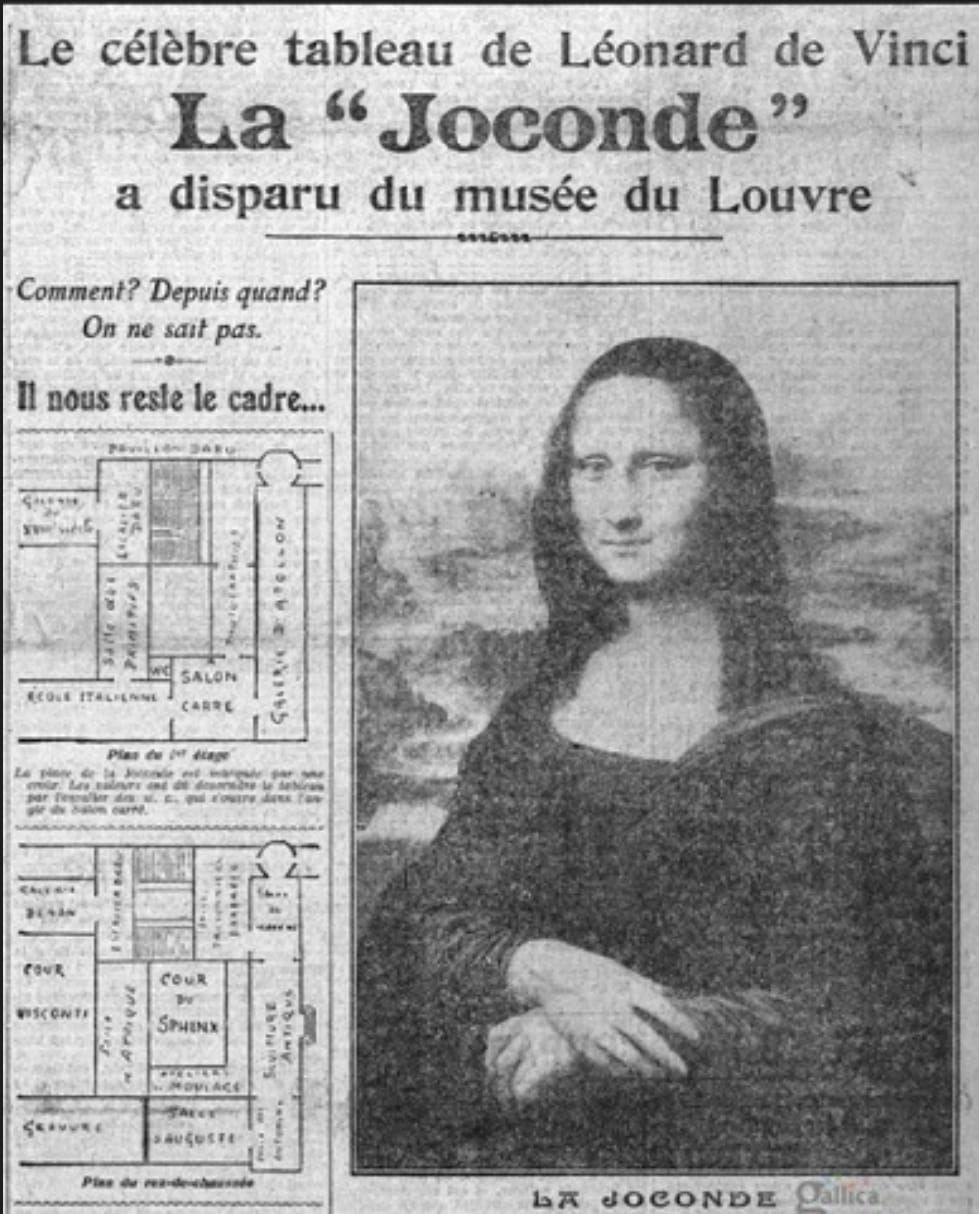 Newspaper headlines of Monalisa (La Joconde) Stolen (Image credits: Wikicommons.org)
Newspaper headlines of Monalisa (La Joconde) Stolen (Image credits: Wikicommons.org)
The Louvre closed for a week. When it reopened on Tuesday, August 29, queues formed outside for the first time. People were pouring in to see the space where the Mona Lisa had once hung.
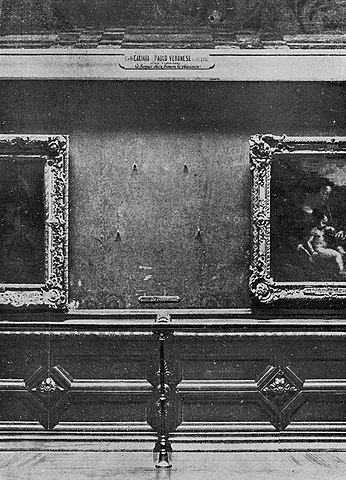 Empty space in Salon Carre, where Monalisa used to be (Image credits: Wikicommons.org)
Empty space in Salon Carre, where Monalisa used to be (Image credits: Wikicommons.org)
Mona Lisa transcended from a mere painting to a Star!
For months, the theft received wall-to-wall newspaper coverage, and conspiracy theories abounded.
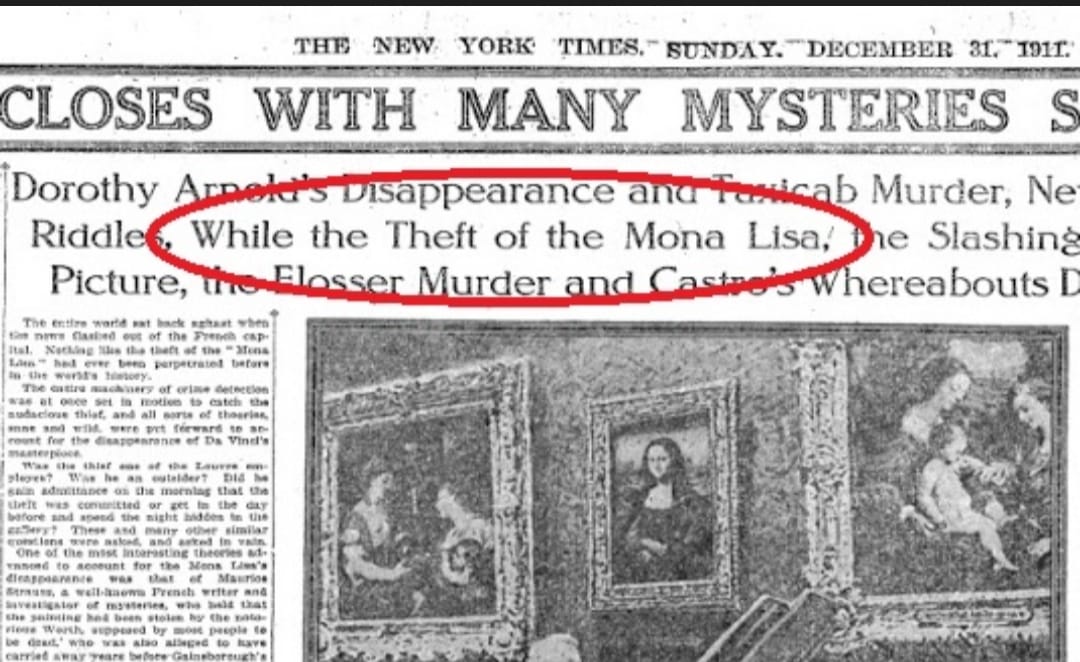 News of Monalisa's theft reaches America (Image credits: Wikicommons.org)
News of Monalisa's theft reaches America (Image credits: Wikicommons.org)
Popular songs were written to commemorate the painting. Postcards of the Mona Lisa sold in unprecedented quantities. Mona Lisa advertised everything from cigarettes to corsets. No painting had ever been reproduced on such a large scale before. American author RA Scotti said Mona Lisa had become "high culture" and "a staple of consumer culture."
Even Pablo Picasso, and his poet friend, Apollinaire became suspects. Because of their association with a Belgian art thief, Honoré Joseph Géry Pieret. He often used to stay with them and had boasted of having sold stolen art from Louvre. But after questioning they were let go.
After four months, the trail went cold. And police had no firm suspects on their list. The world thought it lost Mona Lisa. Finally, on December 12, a portrait painting by Raphael was hung on a blank wall where the Mona Lisa once hung.
It was not until November 1913, that Mona Lisa resurfaced. An Italian named Vincenzo Peruggia wrote to Alfredo Geri, an art dealer based in Florence. Stating he had the Mona Lisa in his possession and wanted to sell it. The art dealer connected with Uffizi director Giovanni Poggi. Together they arranged to meet Vincenzo Peruggia in his hotel room to view the stolen Mona Lisa. While secretly informing the police. On 11 December 1913, Vincenzo Peruggia was arrested for stealing the Mona Lisa. The investigations revealed Vincenzo entered the Louvre on Monday morning. Where he worked wearing a smock, worn by all Louvre workers. Went up to Salon Carré, where Mona Lisa was hung, and took it off when the room was empty. Then he went to a nearby service staircase and removed the frame. Wrapping the smock around the painting, he tucked it under his arm and walked out of the museum.
What motivated Vincenzo Peruggia to steal Mona Lisa?
During his trial in Italy, Vincenzo Peruggia said his motivation was patriotism. While working in Louvre, he came to know about Napolean’s plunder of Italian art during the war. And he thought the Mona Lisa was stolen by Napolean during the Napoleonic wars. Vincenzo Peruggia wanted to right this wrong by bringing Mona Lisa back to Italy.
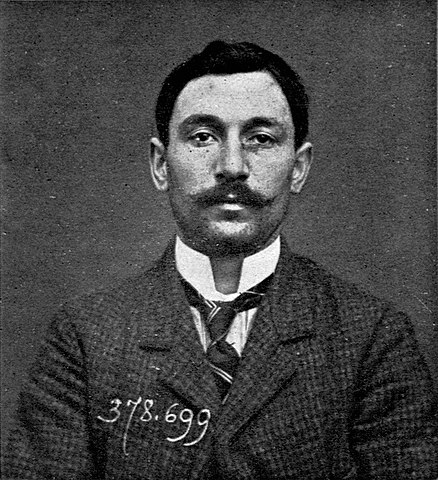 Vincenzo peruggia (Image credits: Wikicommons.org)
Vincenzo peruggia (Image credits: Wikicommons.org)
He did not know that the King of France had bought the painting. Experts scoff at this defense. Pointing out, Vincenzo wanted to sell the painting to an art dealer Alfredo Geri. Whatever may be the motivation, he was hailed as a patriot in Italy. And was given an extremely lenient sentence. He was only sentenced to 1 year and 15 days in jail and released in 7 months. After his release, he served in the Italian army during World War I.
After the war, he married, had a daughter, and returned to France under his birth name, Pietro Peruggia. He died in 1925 at the age of 44.
There was a collective sigh of relief in the art world in 1914. When the news broke that the stolen Mona Lisa painting had been recovered.
 Newspaper reports of Monalisa found (Image credits: Wikicommons.org)
Newspaper reports of Monalisa found (Image credits: Wikicommons.org)
On December 14, 1914, Mona Lisa was put on display at the Uffizi. For two weeks to sell out a crowd of 30,000 people on the first day. Finally on 4 June 1914, Mona Lisa made her triumphal return to France, to her home in Louvre. She left the Louvre as an icon of art but returned as the ART ICON of the world.
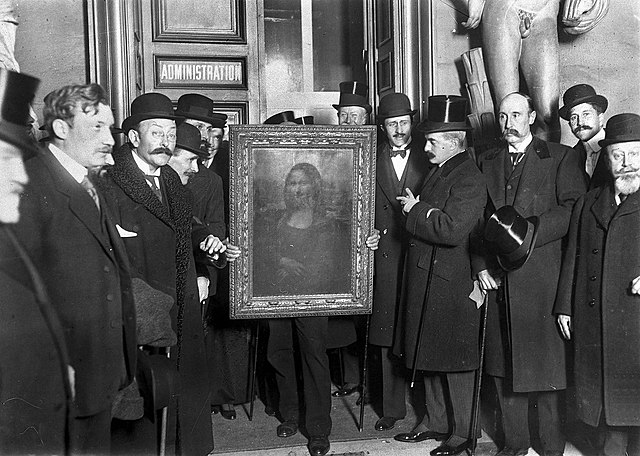 Monalisa returned to Louvre (Image credits: Wikicommons.org)
Monalisa returned to Louvre (Image credits: Wikicommons.org)
Mona Lisa: The star is Born!
By the time she returned to France, Leonardo da Vinci's work, Mona Lisa had become a star among artworks. A must-see attraction, thanks to the extensive wall-to-wall media coverage. She became "famous for being famous". As she ascended to the very top of the art world.
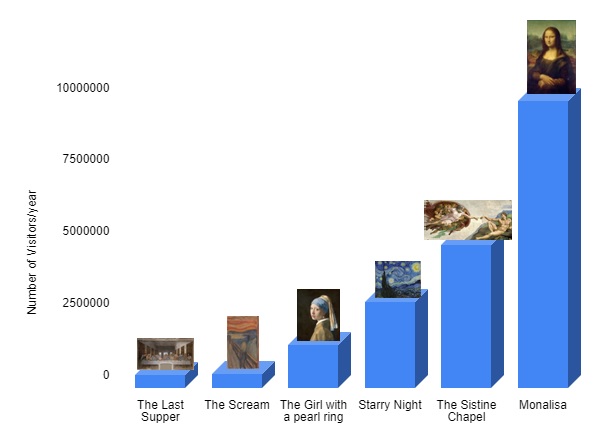 Top 6 paintings of the world by visitors (Image credits: Paintphotographs.com)
Top 6 paintings of the world by visitors (Image credits: Paintphotographs.com)
Over the years, many artists have taken inspiration from the Mona Lisa. They created derivative works which added to her aura of mystery and popularity. French artist Marcel Duchamp parodied the Mona Lisa. Drawing a mustached version of the portrait painting. Titled L.H.O.O.Q. The letters L-H-O-O-Q pronounced in French form the sentence Elle a chaud au cul, colloquially translating into English as "She has a hot ass."
A tour of the Mona Lisa painting to the United States inspired Andy Warhol. He made a series of screenprints of the Mona Lisa in 1963.
Pop artist Keith Haring also took on the Mona Lisa. Juxtaposing her with other figures in a series of collages and prints in 1988.
British street artist Banksy has also made his mark on the Mona Lisa. His stenciled work "Mona Lisa Mujaheddin" depicts her holding a rocket launcher. Other renowned artists, like Salvador Dali and Roy Lichtenstein, have incorporated elements of the Mona Lisa into their works. Reinforcing and expanding her influence in the art world.
How much is Mona Lisa worth?
In 1962 when Monalisa went on a special exhibition tour of the USA. At the request of the US First Lady, Jacqueline Kennedy. The insurers valued the painting at USD 100 million for the move. From the Louvre in Paris, France, to Washington, DC, USA, and then New York City, New York. This was the highest known valuation for the painting. The insurance was not taken out, and instead, money was spent on the security of the painting. The current inflation-adjusted value of the painting will be USD 1 billion. But in reality, Monalisa is priceless. The Louvre museum will not sell it and it is illegal to sell national treasures in France. France24 did a story about selling national treasures. Like the Mona Lisa to ease France's national debt. But it was quickly shot down by experts. So the worth of Monalisa as it stands today is it is priceless and irreplaceable.
Conclusion:
Monalisa today is the most recognized painting in the world. Thanks to her enduring mystery and her popularity. Monalisa is the only painting in the Louvre museum and possibly in the world, in her mailbox. Where legions of her fans send flowers, letters, and gifts to her.
Leanardo made fewer than 20 works compared to the contemporaries of his time. But in Monalisa, he has made a masterpiece that will endure for generations to come.
There you have it. The magical journey of Monalisa. From another renaissance period artwork to the most recognizable painting in the world.
About Us:
Paintphotographs.com is India's leading custom art platform. We turn your favorite photos, pics, and images into luxurious handmade portrait paintings. Our work includes handmade portraits, custom oil reproductions, charcoal drawings, and sketches. As a team of accomplished artists, we use museum-quality canvas, the best international brands of colors such as Winsor & Newton and Daler Rawney. We work with various mediums, including oil, acrylic, mixed media, graphite, and charcoal.
To order a custom handmade oil portrait painting you can visit our order now page. You can order custom Wedding Paintings, Couple Paintings, Memorial Paintings, Family Paintings, Baby portraits and Children Paintings, Photo to paintings, and Pet Portrait Paintings from Photo.
You can visit our pricing page to know the prices of our portrait paintings. To connect with us ping us on our chat messenger on the website, ping us on WhatsApp, call us at 918291070650, or drop us an email at support@paintphotographs.com
You can visit our gallery pages to see our work. We make photo to paintings, couple paintings, memorial paintings, Kids and Baby Portrait paintings, God & Religious Paintings, Old Photo to Paintings, Wedding couple Paintings & Marriage Portraits, Family Paintings, Pet Portrait Paintings, Radha Krishna Paintings, Oil Portraits of Gurus, Saints & Holy Men, Charcoal and Pencil Sketches, Custom Landscape & Cityscape paintings, Contemporary Art Reproduction & Replica Paintings, Old Master Reproduction & Replica Art, Monochrome and Black & White portrait paintings, Historical Portraits and Shivaji Maharaj Paintings, Celebrity & Political Leaders Portraits. We can also merge separate photos to create a single seamless painting called Composite portraits to add deceased loved ones to make a family oil portrait as though they were present.
Our custom handmade portraits make beautiful Anniversary Gifts, Engagement Gifts, Birthday Gifts, Retirement Gifts, Housewarming Gifts, Mother's Day gifts, and luxurious gifts for many important occasions.
Paintphotographs.com provides bespoke services for art patrons, interior designers, and architects. It helps you create the perfect pieces for residential and commercial projects and serves as a platform for artists to showcase their work.
If you are an art aficionado interested in writing a guest post on art, connect with us.
Want to read more? Check our reading recommendations below! Please refer to the Notes and Reference section for sources referenced in the article.
Like this story? Then you will love our podcasts on Spotify. Listen to our deep dives and fascinating stories from the art world. Join our nearly 20,000-strong community on Facebook, WhatsApp, and X.
Want to see our art? Join our community of 500,000+ subscribers on the Paintphotographs YouTube channel, Instagram, and Pinterest for some amazing art pics & art videos!
Recommended Pieces
Uncover the mystical beauty of Shri Krishna paintings and art through the ages | Paintphotographs
A brief history of oil painting technique | Paintphotographs
Ultimate 20 Best Oil Portrait Paintings of John Singer Sargent (Ranked) | Paintphotographs
Photorealism: The Art of making a painting from a photo. | Paintphotographs
The life and paintings of artist and painter KCS Paniker | Paintphotographs
Notes and reference section
Mona Lisa fans decry brief encounter with their idol in Paris
https://www.google.co.in/books/edition/Museum_Skepticism/VIBoW6dDZgIC?hl=en&gbpv=1 (pg35)
6 of the World's Most Visited Paintings — Google Arts & Culture
What is the value of the Mona Lisa? | Britannica
The Secrets Behind The Eyes And Smile Of Mona Lisa
Leonardo da Vinci - Second Florentine period (1500–08) | Britannica
Mona Lisa | Painting, Subject, History, Meaning, & Facts | Britannica
Who stole the Mona Lisa? The world's most famous art heist, 100 years on.
https://archive.ph/20120917212851/http://www.stilearte.it/articolo.asp?IDart=934
$100,000,000 in 1962 → 2022 | Inflation Calculator
Highest insurance valuation for a painting | Guinness World Records

